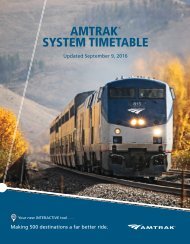Queens
northeast_queens_bus_study_-_final_9-28-15
northeast_queens_bus_study_-_final_9-28-15
You also want an ePaper? Increase the reach of your titles
YUMPU automatically turns print PDFs into web optimized ePapers that Google loves.
, Metropolitan Transportation Authority<br />
might be established is difficult to quantify, and the MTA does not currently have the funding or<br />
resources needed to implement this extension.<br />
Q. Can the MTA extend the Q46 to North Shore Towers?<br />
A. The Q46 is a long route and operates almost the entire length of Union Turnpike from <strong>Queens</strong> to<br />
Nassau County. Extending the route to North Shore Towers would require an extension of approximately<br />
one mile in each direction on either branch. This would add almost two miles to each trip. Long Island<br />
Jewish Hospital is a large trip generator and has a dedicated bus terminal area near the main hospital<br />
entrance. We have also receive significant amounts of comments over the years in opposition to a<br />
possible Q46 extension to North Shore Towers.<br />
Bus Stop Changes<br />
Q. Can the MTA improve the conditions at bus stops at subway stations, particularly 169 th Street Subway<br />
Station?<br />
A. The MTA will continue to evaluate the passenger environment and look for ways to improve the<br />
customer’s experience through better information, more comfortable surroundings, and an increased<br />
feeling of safety. Unfortunately, many of the conditions of the sidewalk along Hillside Avenue are due to<br />
the high number of buses running along the street during the evening rush hour. Buses arrive, discharge<br />
passengers, and load up new passengers. The dwell time for fare collection of so many transfers from<br />
the subway slows down the departure of the bus and therefore prohibits other buses from properly<br />
curbing to pick up passengers. The MTA continues to deploy new technologies to aid in the mitigation of<br />
these issues. BusTime, which provides information for passengers based on the GPS location of the bus,<br />
also provides essential information to MTA operations staff so that they can better adjust the timing and<br />
distribution of buses along the route. The system is new, and the MTA is just beginning to make changes<br />
that will ensure a better experience for all of our passengers.<br />
Other Bus Service Requests<br />
Q: The bus route on my street is local, but can it be turned into a limited?<br />
A: The guidelines for limited service are listed in Section 5: Public Input of this document.<br />
Q. Can the MTA make information clear regarding the numbering of bus routes?<br />
A. The MTA currently has 315 bus routes, by far the largest number in the United States. Almost a third<br />
of this number, consisting of 81 local and limited routes and 22 express routes, operate primarily in<br />
<strong>Queens</strong>. The sheer number of bus routes makes adding extra numbers problematic for customer<br />
understanding.<br />
Q. What is Bus Time and how does it work?<br />
A. Additional information about BusTime is located in Section 4: Quality of Service in this report. Also,<br />
please visit http://web.mta.info/nyct/MTA_BusTime.htm for more information and instructions on how<br />
to use its features.<br />
A‐3



